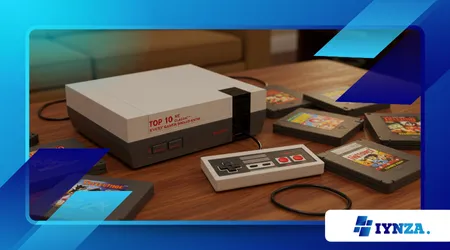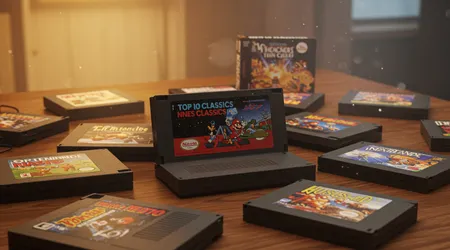Top 10 NES Classics Every Gamer Should Know

For those who think gaming began with high-definition graphics and elaborate online worlds, a history lesson is due.
Anúncios
The Nintendo Entertainment System (NES), launched globally in the mid-1980s, didn’t just save the video game industry; it wrote the playbook. Understanding its legacy is crucial, and this curated list of NES Classics Every Gamer Should Know provides the essential curriculum.
These titles established genres, perfected control schemes, and introduced design philosophies that continue to define indie and AAA games today.
They are the foundational texts of digital entertainment. While modern games boast complexity, these 8-bit wonders focused purely on elegant design, rewarding difficulty, and innovative mechanics.
Ignoring them means missing the fundamental roots of beloved franchises and the core design principles of compelling gameplay. Dive in to discover the true genesis of modern gaming excellence.
Why are 8-Bit Limitations So Important to Design?
The tight constraints of the NES hardware limited color palettes, small memory, and simple processors—forced unparalleled creativity from developers.
How Did Hardware Limits Spark Innovation?
Developers couldn’t rely on spectacle or huge worlds; they had to rely on pure gameplay mechanics. They needed elegant, intuitive design that fit within restrictive cartridge memory sizes.
This constraint resulted in games with incredibly focused and refined core loops. Every asset, enemy, and level design element had to serve a crucial purpose.
The lessons learned in maximizing impact within limits are directly applied in modern indie development, making these NES Classics Every Gamer Should Know an ongoing inspiration.
++ How Indie Horror Games Are Redefining Fear
The Genesis of ‘Nintendo Hard’ Difficulty
The limited processing power meant saving progress was often impossible or reserved for complex passwords. This forced developers to embrace high, yet fair, difficulty.
Games demanded mastery, not just grinding. The challenge came from perfecting timing and learning patterns, leading to incredible player satisfaction upon completion.
This demanding design philosophy built a dedicated fanbase focused on skill and persistence, a precursor to the modern “Soulslike” genre.

The Platforming Perfected: Mario and the Genre’s Birth
The Super Mario Bros. trilogy defined what a 2D platformer should be, creating conventions still used universally.
Which Titles Are the Foundation of Side-Scrolling?
Super Mario Bros. (1985) is the indisputable genesis of the modern platformer, teaching players how to move right and introducing the hidden secrets of the scrolling world.
Also read: Best retro indie games for beginners
Why Was Super Mario Bros. a Design Breakthrough?
Shigeru Miyamoto’s masterful level design subtly taught players the mechanics the first Goomba teaches jumping, the question block teaches power-ups. It was a tutorial without explicit instructions.
The game broke the screen-by-screen progression of older arcade titles. It gave the player agency in a continuous, fast-paced world, setting a gold standard for the NES Classics Every Gamer Should Know.
It remains one of the best-selling NES games of all time, with its initial release selling over 40.24 million units, a monumental commercial and creative achievement.
Read more: Exploring the Revival: Modern Takes on Classic 80s Vectrex Console
What Did Super Mario Bros. 3 Add to the Formula?
Super Mario Bros. 3 (1988) dramatically expanded the template, introducing the world map for non-linear progression and revolutionary power-ups like the Tanooki Suit.
The sheer variety of level themes, boss encounters, and secret zones pushed the hardware limits, showcasing the NES’s true potential late in its life cycle. It elevated the series from simple jumping to exploration and deep mechanical variety.
Action and Exploration: The Birth of the Metroidvania
Beyond platforming, two landmark titles cemented the structure for action-adventure games that required extensive map exploration.
How Did Metroid and Castlevania Define a New Genre?
These titles combined precise action with non-linear world traversal, forcing players to revisit areas with new abilities.
The Legacy of Metroid’s Atmosphere
Metroid (1986) established the template for isolated, atmospheric exploration. Its sprawling, labyrinthine world demanded patient backtracking and rewarded curiosity with essential upgrades.
It pioneered the concept of verticality in a side-scroller, using Samus’s morph ball and jumps to unlock new areas. The sense of lonely, deep-space discovery remains unmatched.
The shocking reveal of Samus’s identity at the end was an early example of narrative depth and is essential knowledge for anyone studying NES Classics Every Gamer Should Know.
Castlevania and the Art of Brutal, Skill-Based Combat
Castlevania (1986) offered a stark contrast: linear progression, but with incredibly deliberate, stiff character control. This demanded precise combat planning.
Simon Belmont’s fixed jump and whip created a rhythm of combat that rewarded discipline over button-mashing. Modern indie games like Shovel Knight directly cite this structured difficulty.
Analogy: Playing Castlevania is like mastering a challenging classical instrument; the rigid controls are not flaws, but the constraints of the composition that, once mastered, allow for elegant performance.
Role-Playing and Narrative Depth
The NES proved that deep, engaging narratives and complex stat systems could thrive on a console format.
Which Games Established Console RPGs?
Final Fantasy and Dragon Quest laid the groundwork for the JRPG genre, focusing on epic stories, turn-based combat, and party management.
Final Fantasy‘s Technical and Narrative Ambition
Final Fantasy (1987) introduced a robust class system and strategic, menu-driven combat that felt modern even at the time. Its expansive world map was an incredible feat for the NES.
Its focus on a grand, multi-continental narrative proved that consoles could deliver stories rivaling early PC role-playing games. This technical ambition defines many NES Classics Every Gamer Should Know.
The Indie Influence of Mega Man 2
While an action game, Mega Man 2 (1988) introduced a revolutionary, non-linear progression structure. Allowing the player to choose any of the eight robot masters immediately was unprecedented.
Beating a boss granted a new weapon, forcing players to strategically assess which weapon was most effective against which boss. This dynamic choice structure deeply influenced modern roguelike and Metroidvania indie titles.
Example: Modern indie hits like Shovel Knight and Axiom Verge directly blend the tough-but-fair platforming of Mega Man with the non-linear exploration of Metroid. These games are proof the design templates remain gold.
Top 5 Most Influential NES Classics (Beyond Sales)
| Rank | Title (Year) | Core Innovation Established | Direct Influence on Modern Gaming |
| 1 | Super Mario Bros. (1985) | Horizontal, continuous side-scrolling; Hidden block mechanic | Standard for all 2D platformers; Level design tutorials |
| 2 | The Legend of Zelda (1986) | Non-linear open-world exploration; Item-gated progression | Zelda-like adventure games; Action RPGs |
| 3 | Mega Man 2 (1988) | Boss-selection screen; Unique weapon-cycling against specific bosses | Modern non-linear roguelikes and boss rushes |
| 4 | Metroid (1986) | Atmospheric exploration; Ability-based backtracking (Metroidvania) | Hollow Knight, Ori and the Blind Forest (Indie Genre) |
| 5 | Castlevania (1986) | Deliberate, rhythmic, skill-based combat with minimal platforming | ‘Nintendo Hard’ difficulty; Gothic aesthetics in pixel art |
Conclusion: The Enduring Legacy
The importance of these NES Classics Every Gamer Should Know cannot be overstated. They are more than just nostalgic memories; they are the architectural blueprints of modern game design.
From the environmental storytelling of Metroid to the genre-defining precision of Super Mario Bros., these titles set the standards for character control, difficulty scaling, and player engagement.
Their influence is evident today in the indie space, where budget constraints mirror the hardware limits of the 8-bit era, forcing the same kind of essential creativity.
Every serious gamer owes it to themselves to experience these foundational texts and appreciate how complex mechanics were born from simple beginnings.
Which of these 8-bit legends had the biggest impact on your own gaming journey? Share your favorite NES memory in the comments and let us know!
Frequently Asked Questions (FAQ)
Q: Why isn’t a game like Duck Hunt on the main list?
A: Duck Hunt (1984) was iconic for its use of the Zapper Light Gun, a unique peripheral, but its NES Classics Every Gamer Should Know influence on core game design mechanics (platforming, RPG, action) is less profound than the other listed titles. We focus on blueprints, not just peripherals.
Q: Can I still play these original games legally in 2025?
A: Yes. Nintendo offers a massive library of NES Classics Every Gamer Should Know available through the Nintendo Switch Online + Expansion Pack subscription service, which provides accurate emulation of the original hardware.
Q: Were NES games truly difficult, or is that just nostalgia?
A: The difficulty was genuinely high. The hardware limitations meant fewer frames of animation and less forgiving hitboxes, demanding pixel-perfect precision. This challenge is objectively greater than most modern mainstream titles.
